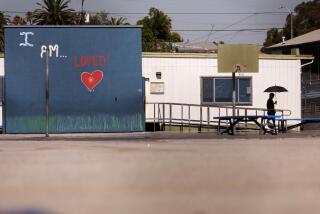Schools Are Struggling
- Share via
In many households, the end of summer means back to school. No more days at the beach or summer jobs for the youngsters. More frantic schedules for parents juggling work, driving to and from school, soccer and the library.
But at some schools the situation is even more complicated, because rather than shutting for the summer, classes are in session year-round. When overcrowding gets worse, schools stagger the starting times of classes. That takes a special toll on parents, especially when both are working.
The 22 elementary schools in the Anaheim City School District can start classes at 7:45 a.m., 10:30 a.m. or 12:30 p.m. Children walk out the schoolhouse door at 1 p.m. or 4 p.m. Parents with two or three children starting classes at two or three different times have to balance jobs, driving time and household chores to be sure their children are dropped off and picked up at the right times.
The school district needs to do as much as it can to give siblings the same schedules. Parents and students benefit from coordinated classes.
That’s not to say it’s easy for the district, which in recent decades has experienced remarkable growth in the number of students without an accompanying increase in the number of schools.
In about 10 years, enrollment has gone from 11,000 to 20,000. The recent reduction in class size in the lower grades has imposed further strains. Teachers escort students from classroom to library to outdoor lunch tables in a well-choreographed ballet that is necessary because no space is vacant for long.
During the primary elections last April, Anaheim voters were asked to support a bond measure that would have built new elementary schools and repaired existing ones. More than half the voters agreed, 55%. Unfortunately for the district, a two-thirds vote is needed to pass school bonds at the local level.
Bond supporters have vowed to try again. When they do, they will have to work hard to persuade city business owners, who did not back the bond measure last time. And they need to assure voters that the money will be well spent, perhaps by instituting a committee to monitor disbursement of the funds.
Anaheim City may be an especially hard-pressed district, but it is not alone in fighting overcrowding.
The Huntington Beach City district reopened Peterson Elementary school in September of last year, about a decade after it closed. The school was needed because smaller classes require more classrooms and because of the expectation that the district will keep growing. Across Orange County, six other formerly closed campuses were reopened.
In many cases, school personnel teamed up with parents to make the reopenings a special event, instilling a feeling of pride in facilities that were refurbished for the benefit of a new generation of students.
That kind of cooperation makes it easier for schools to do a good job of educating pupils. With the increased enrollment across Orange County expected in the years ahead, such teamwork will be necessary.
Also needed will be money to build new schools, repair existing ones or overhaul those that have been mothballed for years. When voters decided favorably on Proposition 1A last week, passage fulfilled the hopes of educators in schools like Huntington Beach High, where the heating and air-conditioning systems have been erratic for years, toilets sometimes don’t flush and the pool has been empty for five years because of a lack of money to maintain it.
Buena Park last week put its own referendum on the ballot, seeking $13.8 million to upgrade six elementary schools and one middle school. All are more than 30 years old. Passage of the measure indicated a welcome willingness to recognize that buildings age and deteriorate and require repairs.
More to Read
Sign up for Essential California
The most important California stories and recommendations in your inbox every morning.
You may occasionally receive promotional content from the Los Angeles Times.













